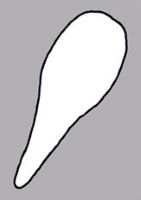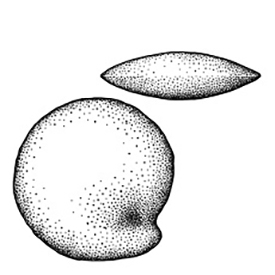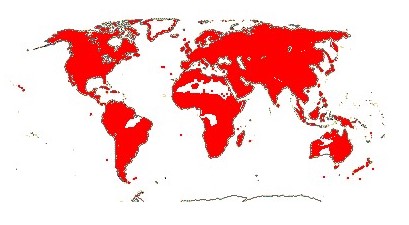Family name: Campanulaceae Jussieu
Synonym(s): Cyananthaceae J. Agardh; Cyphiaceae A. DC.; Cyphocarpaceae Reveal & Hoogland; Jasionaceae Dumort.; Lobeliaceae Juss., nom. cons.; Nemacladaceae Nutt.
Common name(s): bellflower family
*Number of genera/species: 92/2,300
List of genera records in GRIN-Global
Fruit a berryberry:
an indehiscent, fleshy fruit with one or a few to many seeds. The flesh may be homogenous throughout. Or, if the outer part is hard, firm, or leathery, referred to as an hesperidium. Septa are present in some, and the seeds may be arillate or with a fleshy testa. or capsulecapsule:
or capsulecapsule:
a dry, dehiscent fruit derived from a compound ovary , rarely a schizocarpschizocarp:
, rarely a schizocarpschizocarp:
usually dry fruit splitting between two or more locules to form distinct, indehiscent, usually one seeded segments; fruit derived from a single, superior or inferior, compound ovary; compare to mericarp (Theodorovia), 0.6–35 mm long, globoseglobose:
(Theodorovia), 0.6–35 mm long, globoseglobose:
3D shape—more or less spherical to angularangular:
to angularangular:
2D shape—having sides that meet at acute or obtuse angles
, rarely beakedbeak:
a usually firm, terminal appendage, sometimes tapered , usually with many seeds, sometimes subtended or crowned by persistent calyxcalyx:
, usually with many seeds, sometimes subtended or crowned by persistent calyxcalyx:
the outer whorl of the perianth; all the sepals of a flower lobes. CapsulesCapsule:
lobes. CapsulesCapsule:
a dry, dehiscent fruit derived from a compound ovary usually dehiscedehiscent:
usually dehiscedehiscent:
(v. dehisce) splitting open at maturity to release contents (of a fruit) regularly by apicalapical:
regularly by apicalapical:
at or pertaining to the end of the seed or fruit distal from its point of attachment (i.e., base)
or laterallateral:
(of embryo) embryo lies along the side of the seed, generally towards one end; of, at, or from the side; in grasses, can refer to the sides adjacent to the dorsal and ventral sides
valves, slits, or pores. Operculumoperculum:
a dehiscent cap (or lid) of a seed or fruit that opens during germination or dehiscence present in Craterocapsa, Lysipomia, Parishella, Siphocodon, Rhigiophyllum, and Roella. Pericarppericarp:
present in Craterocapsa, Lysipomia, Parishella, Siphocodon, Rhigiophyllum, and Roella. Pericarppericarp:
fruit wall or fruit coat
brown (capsulescapsule:
a dry, dehiscent fruit derived from a compound ovary ) or black, blue, purple, red to yellow, greenish, or white (berriesberry:
) or black, blue, purple, red to yellow, greenish, or white (berriesberry:
an indehiscent, fleshy fruit with one or a few to many seeds. The flesh may be homogenous throughout. Or, if the outer part is hard, firm, or leathery, referred to as an hesperidium. Septa are present in some, and the seeds may be arillate or with a fleshy testa. ), usually thin, dry or membranousmembranous:
), usually thin, dry or membranousmembranous:
texture—extremely thin, pliable, and fairly tough
(capsulescapsule:
a dry, dehiscent fruit derived from a compound ovary ) or fleshy (berriesberry:
) or fleshy (berriesberry:
an indehiscent, fleshy fruit with one or a few to many seeds. The flesh may be homogenous throughout. Or, if the outer part is hard, firm, or leathery, referred to as an hesperidium. Septa are present in some, and the seeds may be arillate or with a fleshy testa. ), glabrousglabrous:
), glabrousglabrous:
without hairs
or pubescentpubescent:
surface relief—bearing hairs
, smooth or 5–10-veined, papillosepapillate:
surface relief—bearing minute, distinct, broad-based projections, tapering to a rounded apex , sulcatesulcate:
, sulcatesulcate:
surface relief—having one or more elongate, relatively narrow and shallow depressions or grooves to deeply sulcatesulcate:
to deeply sulcatesulcate:
surface relief—having one or more elongate, relatively narrow and shallow depressions or grooves .
.
Seeds compressedcompressed:
flattened; in grasses, used to denote compression (not necessarily flattened) either laterally or dorsiventrally
or not, globoseglobose:
3D shape—more or less spherical to trigonoustrigonous:
to trigonoustrigonous:
3D shape—having three faces that meet at distinct angles; triangular in outline
, lens-shapedlens-shaped:
2D shape—round and flattened with two curved (convex) surfaces
or tereteterete:
approximately circular in cross section; width and thickness approximately equal
 in transection, usually 0.2–0.5(–4.5) mm long. Seed coat brown to black, sometimes orange, yellow, or white, shinyshiny:
in transection, usually 0.2–0.5(–4.5) mm long. Seed coat brown to black, sometimes orange, yellow, or white, shinyshiny:
uniformly reflecting a high proportion of incident light at all angles or dulldull:
or dulldull:
reflecting only a low proportion of incident light, with no apparent sheen , thin, smooth or variously ornamented, sometimes longitudinally keeledkeel:
, thin, smooth or variously ornamented, sometimes longitudinally keeledkeel:
a longitudinal ridge, like the keel of a boat, formed by the lengthwise folding of a structure, such as a lemma or palea
 . Broadly or narrowly winged in Cyphia spp., Codonopsis spp., Lobelia spp., Ostrowskia, Sachokiella, Trematolobelia, and Wahlenberia spp.
. Broadly or narrowly winged in Cyphia spp., Codonopsis spp., Lobelia spp., Ostrowskia, Sachokiella, Trematolobelia, and Wahlenberia spp.
Embryo usually well developed, partially filling seed coat, axileaxile:
on or of the axis
and centric, linearlinear:
(shape) long, narrow, and uniform in width; (of embryo) embryo is straight and much longer than wide or foliatefoliate:
or foliatefoliate:
appearing leaf-like
(spatulatespatulate:
2D shape—like a spatula; rounded at the apex, with base long and tapered; (of embryo) embryo is straight and axile and centric with the cotyledons expanded to form the shape of a spatula or spoon; (of cotyledons) cotyledons expanded and wider than the stalk but not invested into the stalk ), straight.
), straight.
Endosperm copious or moderate, fleshy, smooth, oily, rarely starchy.
| Fruit | |
| Type | capsulecapsule: a dry, dehiscent fruit derived from a compound ovary  , berryberry: , berryberry:an indehiscent, fleshy fruit with one or a few to many seeds. The flesh may be homogenous throughout. Or, if the outer part is hard, firm, or leathery, referred to as an hesperidium. Septa are present in some, and the seeds may be arillate or with a fleshy testa.  , schizocarpschizocarp: , schizocarpschizocarp:usually dry fruit splitting between two or more locules to form distinct, indehiscent, usually one seeded segments; fruit derived from a single, superior or inferior, compound ovary; compare to mericarp  |
| Size range | 0.6–35 mm long |
| Shape(s) | broadly campanulatecampanulate: 3D shape—bell-shaped, circular in cross-section, inflated proximally, broadening gradually until flared distally , conicalconical: 3D shape—cone-shaped, with the point of attachment at the broad end  , ovoidovoid: , ovoidovoid:3D shape—ovate  , globoseglobose: , globoseglobose:3D shape—more or less spherical  , clavateclavate: , clavateclavate:3D shape—club-shaped, with attachment at or near narrow end (compare obclavate)  , angularangular: , angularangular:2D shape—having sides that meet at acute or obtuse angles , cylindriccylindrical: 3D shape—a cylinder, with parallel sides and a circular cross-section; tubular or rod-shaped (often slightly curvedcurved: (of embryo) linear embryo is curved into an arch or horseshoe with the ends far apart  ), turbinateturbinate: ), turbinateturbinate:3D shape—broadly obovoid-obconic , hemisphericalhemispherical: 2D shape—shaped like half a sphere , oblongoblong: 2D shape—much longer than broad with nearly parallel sides, corners are rounded  , ellipsoidellipsoid: , ellipsoidellipsoid:3D shape—elliptic , pear-shaped |
| Texture | capsulescapsule: a dry, dehiscent fruit derived from a compound ovary  - thin, membranousmembranous: - thin, membranousmembranous:texture—extremely thin, pliable, and fairly tough , paperypapery: texture—papyraceous, chartaceous; very thin, pliable, and readily torn; like paper berries - fleshy and sometimes inflated (e.g. Burmeistera, Centropogon) |
| Surface relief | smooth, 5–10-veined, papillosepapillate: surface relief—bearing minute, distinct, broad-based projections, tapering to a rounded apex  , sulcatesulcate: , sulcatesulcate:surface relief—having one or more elongate, relatively narrow and shallow depressions or grooves  to deeply sulcatesulcate: to deeply sulcatesulcate:surface relief—having one or more elongate, relatively narrow and shallow depressions or grooves  |
| Color(s) | capsulescapsule: a dry, dehiscent fruit derived from a compound ovary  - brown - brown berries - black, blue, purple, red to yellow, greenish, white |
| Unique features | Brown capsulescapsule: a dry, dehiscent fruit derived from a compound ovary  dehiscing by valves, slits or pores, either at the apexapex: dehiscing by valves, slits or pores, either at the apexapex:the point farthest from the point of attachment, or the "tip" of an organ  (above the calyxcalyx: (above the calyxcalyx:the outer whorl of the perianth; all the sepals of a flower  lobes) or laterally (below the calyxcalyx: lobes) or laterally (below the calyxcalyx:the outer whorl of the perianth; all the sepals of a flower  lobes) and with numerous minute, dark-colored seeds. Or, dark- to light-colored, fleshy berriesberry: lobes) and with numerous minute, dark-colored seeds. Or, dark- to light-colored, fleshy berriesberry:an indehiscent, fleshy fruit with one or a few to many seeds. The flesh may be homogenous throughout. Or, if the outer part is hard, firm, or leathery, referred to as an hesperidium. Septa are present in some, and the seeds may be arillate or with a fleshy testa.  with numerous, minute seeds and no central placental mass. with numerous, minute seeds and no central placental mass. |
| Seed | |
| Size range | 0.3–4.5 mm long |
| Shape(s) | globoseglobose: 3D shape—more or less spherical  , lenticularlenticular: , lenticularlenticular:3D shape—lens-shaped; biconvex  , ellipsoidellipsoid: , ellipsoidellipsoid:3D shape—elliptic , fusiformfusiform: spindle-shaped; broadest at the middle and tapering at both ends  , oblongoblong: , oblongoblong:2D shape—much longer than broad with nearly parallel sides, corners are rounded  , cylindriccylindrical: , cylindriccylindrical:3D shape—a cylinder, with parallel sides and a circular cross-section; tubular or rod-shaped , ovoidovoid: 3D shape—ovate  , often reniformreniform: , often reniformreniform:2D or 3D shape—kidney-shaped  , angledangular: , angledangular:2D shape—having sides that meet at acute or obtuse angles , trigonal |
| Surface relief | smooth, ribbedribbed: surface relief—wide, prominent, linear ridges that are generally rounded and longitudinally situated on the surface  , pittedpitted: , pittedpitted:surface relief—surface with small depressions in which the areas between the hollows do not take on the appearance of a true reticular net  , longitudinally keeledkeel: , longitudinally keeledkeel:a longitudinal ridge, like the keel of a boat, formed by the lengthwise folding of a structure, such as a lemma or palea  , reticulatereticulate: , reticulatereticulate:surface relief—netted, raised walls or concave grooves forming a net-like surface pattern with flat, concave, or convex interspaces  , striatestriate: , striatestriate:surface relief—having fine, parallel lines, grooves or ridges  , alveolatealveolate: , alveolatealveolate:surface relief—reticulated, honeycombed; ridges that intersect to form polygonal cells with a regular size and shape similar to a honeycomb  , wrinkledwrinkled: , wrinkledwrinkled:surface relief—shallow, irregular folds and furrows covering the surface; appearing overall though crumpled and then spread out  , wartywarty: , wartywarty:surface relief—distinct, rounded projections that are large relative to the fruit size; tuberculate, verrucose  |
| Color(s) | brown (all shades), black, orange, yellow, white |
| Unique features | Usually dark-colored, dust-like (0.2–0.5 mm long) seeds, not compressedcompressed: flattened; in grasses, used to denote compression (not necessarily flattened) either laterally or dorsiventrally , and often with raised sculpturing or fine parallel lines on seed coats. |
| Other | |
| Embryo | usually well developed, partially filling seed coat, axileaxile: on or of the axis and centric, linearlinear: (shape) long, narrow, and uniform in width; (of embryo) embryo is straight and much longer than wide  or foliatefoliate: or foliatefoliate:appearing leaf-like (spatulatespatulate: 2D shape—like a spatula; rounded at the apex, with base long and tapered; (of embryo) embryo is straight and axile and centric with the cotyledons expanded to form the shape of a spatula or spoon; (of cotyledons) cotyledons expanded and wider than the stalk but not invested into the stalk  ), straight ), straight |
| Nutritive tissue | endosperm copious or moderate, fleshy, smooth, oily, rarely starchy |

Distribution map courtesy of Angiosperm Phylogeny Website.
Bingham et al. 2021+Bingham et al. 2021+:
Bingham MG, Willeman A, Wursten BT, Ballings P, and Hyde MA. 2021. Flora of Zambia. Accessed January 2021–April 2024. URL: https://www.zambiaflora.com; Ghazanfar and Edmondson 2013Ghazanfar and Edmondson 2013:
Ghazanfar SA and Edmondson JR, eds. 2013. Lythraceae to Campanulaceae In: Flora of Iraq, Vol 5, part 2. Royal Botanic Gardens, KEW, London UK. 360 pp.; Hong 2015Hong 2015:
Hong D-Y. 2015. A Monograph of Codonopsis and Allied Genera (Campanulaceae). Elsevier Science & Technology, Science Press Beijing, London UK. 256 pp.; Hutchinson and Dalziel 1954–1972Hutchinson and Dalziel 1954–1972:
Hutchinson J and Dalziel JM, revised by Keay RWJ and Hepper FN. 1954–1972. Flora of West Tropical Africa, ed. 2, 3 Vols. 2300 pp.; Hyde et al. 2021aHyde et al. 2021a:
Hyde MA, Wursten BT, Ballings P, and Coates Palgrave M. 2021a. Flora of Botswana. Accessed January–April 2024. URL: https://www.botswanaflora.com/index.php; Hyde et al. 2021c+Hyde et al. 2021c+:
Hyde MA, Wursten BT, Ballings P, and Coates Palgrave M. 2021c+. Flora of Zimbabwe. Accessed January 2021–April 2024. URL: https://www.zimbabweflora.co.zw/index.php; Kirkbride et al. 2006Kirkbride et al. 2006:
Kirkbride JH, Jr, Gunn CR, and Dallwitz MJ. 2006. Family guide for fruits and seeds, vers. 1.0. Accessed September 2020-January 2022. URL: https://nt.ars-grin.gov/seedsfruits/keys/frsdfam/index.cfm .; Kubitzki et al. 1990+Kubitzki et al. 1990+:
Kubitzki K et al., eds. 1990+. The families and genera of vascular plants. 7+ vols. Berlin etc.; Shetler and Morin 1986Shetler and Morin 1986:
Shetler SG and Morin NR. 1986. Seed Morphology in North American Campanulaceae. Annals of the Missouri Botanical Garden 73 (4): 653&-688. https://doi.org/10.2307/2399199; USDA 1980USDA 1980:
United States Dept. of Agriculture (USDA). 1980. Major weed family identification guide. Hyattsville Md, United States ; Thulin 1977Thulin 1977:
Thulin M. 1977. Campanulaceae. In: Flore d’Afrique centrale (Zaïre&-Rwanda&-Burundi), Spermatophytes, Bamps P, ed. Jardin botanique national de Belgique, Meise; Thulin 1984Thulin 1984:
Thulin M. 1984. Lobeliaceae. In: Flora of Tropical East Africa, Polhill R, ed. Prepared at the Royal Botanic Gardens, Kew with Assistance from the East Africa Herbarium. Balkema, Netherlands. 59 pp.; Thulin 1985Thulin 1985:
Thulin M. 1985. Lobeliaceae. In: Flore d’Afrique centrale (Zaïre&-Rwanda&-Burundi), Spermatophytes, Bamps P, ed. Jardin Botanique National de Belgique, Meise.; Tutin et al. 1976Tutin et al. 1976:
Tutin TG, Heywood VH, Burges NA, and Valentine DH, eds. 1976. Flora Europaea Vol 4: Plantaginaceae to Compositae (and Rubiaceae). Cambridge University Press, Cambridge UK. 534 pp.; Zhengyi et al. 2004+Zhengyi et al. 2004+:
Zhengyi W, Raven PH, and Deyuan H. 2004+. Flora of China [online]. 25 vols. Science Press, Beijing China & Missouri Botanical Garden, St. Louis USA. Accessed January–March 2024. http://flora.huh.harvard.edu/china/
*The number of genera and species is based on Christenhusz and Byng 2016Christenhusz and Byng 2016:
Christenhusz MJM and Byng JW. 2016. The number of known plant species in the world and its annual increase. Phytotaxa 261 (3): 201-217. https://doi.org/10.11646/phytotaxa.261.3.1, which may differ from the number of genera in GRIN-Global.